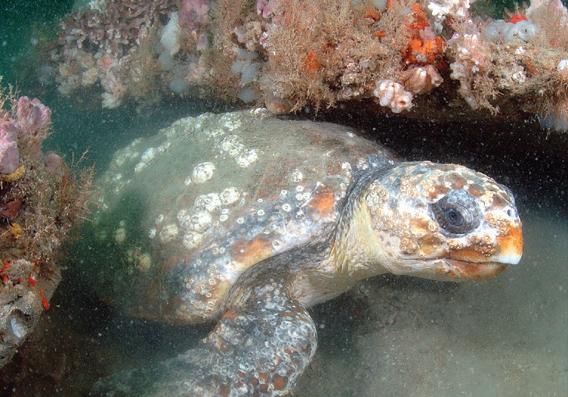
2 minute read
Around the Reef
By Rebecca Munday Communications Intern Gray’s Reef National Marine Sanctuary
Picture an adult loggerhead sea turtle sleeping on the sandy sea floor under a four-foot tall ledge made of sandstone rock, with jagged edges and lots of nooks and crannies. The sea turtle’s tail cannot be seen outside the shell, so she must be female.
Advertisement
She rests under the ledge, conserving her energy before she swims to the surface of the ocean again to breathe. Like other loggerheads and all other species of sea turtles, she’s a reptile and can’t breathe underwater. Yet, if she rests under this rock a while, she won’t have to swim to the surface every half hour. Instead, she can slow her metabolism down and wait a few hours to breathe.
She weighs about 250 pounds and has a massive head, because she has to support the powerful jaw she uses to crush the shells of mollusks and horseshoe crabs she eats while foraging the sandy sea floor.
Sometimes when she looks for crabs, whelks, or mollusks to eat, she finds one that doesn’t taste or feel quite right in her jaw, but she eats it anyway, because food is food. But the oddly textured and strange tasting shells are not food after all, they are bits of plastic and trash that invade the sea turtles’ habitat.
Consequences of eating plastic and other trash are dire for this loggerhead. She may die after ingesting fishing line, plastic bags, floating tar or oil, and other discarded materials that she mistakes for food. Luckily, many boaters, fishers, and beachgoers have begun to take action to protect marine life, and the status of loggerhead sea turtles recently improved from an endangered species to a threatened species. Still, there is work to be done.
The more researchers know about the life stages and habits of the sea turtles at the sanctuary, the better they can protect the turtles and their habit from further decline. On Gray’s Reef’s eightday expedition on board the NOAA Ship Nancy Foster in August, research divers and ship crew saw a total of 11 loggerhead sea turtles across 58 sites. Sightings like these help scientists learn more about the loggerheads’ growth, population size, nesting patterns, migration patterns, and foraging habits.
You can learn about loggerheads and other sea turtles that use the sanctuary by visiting graysreef.noaa.gov/science/research/seaturtles.html to see a new collection of articles and maps that tell the story of all the turtle sighting recorded at Gray’s Reef in the last 27 years, and find out how you can help protect sea turtles.
For Information contact Michelle Riley: michelle.riley@noaa.gov Loggerhead sea turtle swimming at Gray's Reef National Marine Sanctuary, August 2021 Photo by Kimberly Roberson, NOAA

Loggerhead sea swimming at the surface at Gray's Reef in August. Photo by Ben Prueitt

A loggerhead rubbing its carapace on a ledge at GRNMS. Photo by Greg McFall, NOAA








